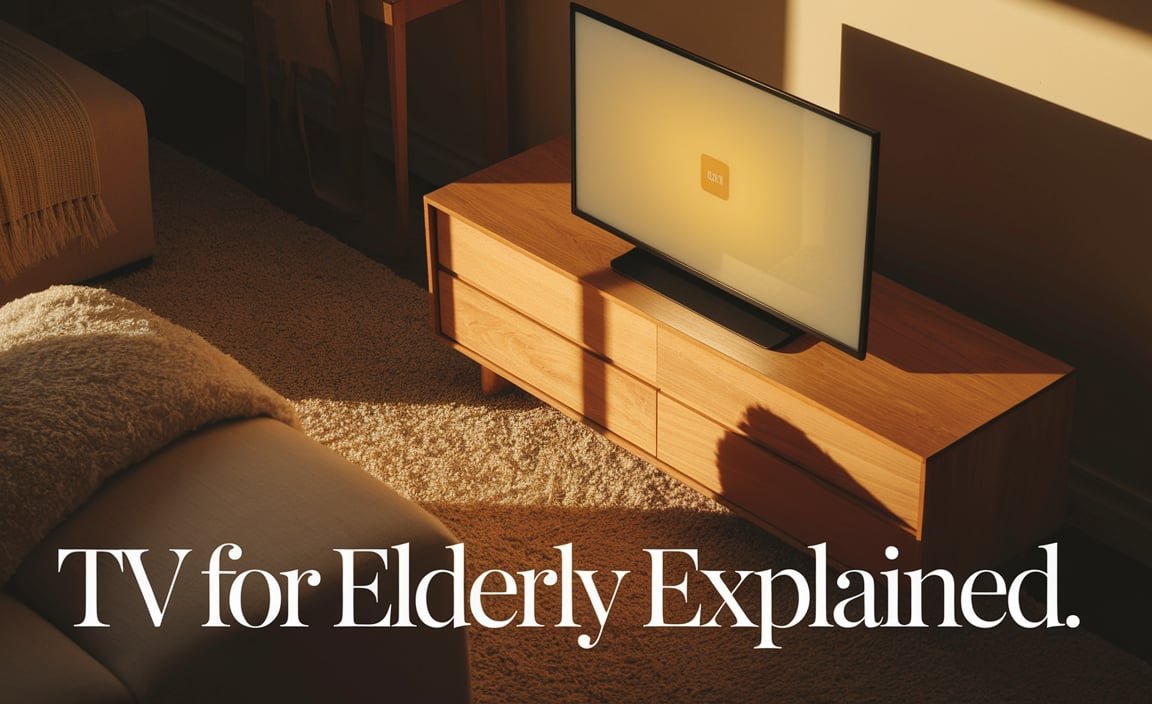Bolded Quick Summary (Top of Article)
Choosing the right screen size setup is surprisingly simple when you consider viewing distance and room size. For most living rooms, a 55-inch to 65-inch TV offers an immersive experience without being overwhelming. For computer setups, desk space dictates smaller monitors, typically 24 to 32 inches. This guide will help you find your perfect screen size for any space.
Hey there, tech friends! Bob E Riley here from Aimguider. Ever walked into a room and felt like the TV was way too big, or maybe too small for everyone to enjoy the show? Or perhaps you’re setting up a new computer desk and staring at a blank space, wondering what size monitor will actually feel right and not make your eyes water? It’s a super common question, and honestly, it can feel a bit overwhelming with all the options out there. But don’t you worry! We’re going to break down exactly how to choose the perfect screen size for your home, office, or gaming den. Get ready to make your viewing and computing experiences totally awesome!
Finding Your Sweet Spot: The Ultimate Screen Size Guide
Picking the right screen size isn’t just about getting the biggest TV you can afford. It’s about creating the best viewing experience for where you’ll be using it. Think of it like choosing the perfect pair of headphones; it should feel just right for you! We’ll cover everything from how far away you’ll be sitting to the kind of content you enjoy most. Let’s dive in and make sure your next tech purchase is a winner.
Step 1: Measure Your Viewing Distance
This is the most crucial step, hands down. How far will your eyes be from the screen? This simple measurement will guide you to the ideal screen size, whether it’s for a cinematic TV experience or a productive computer setup.
For TVs: The Bigger, The More Immersive (Within Reason!)
For a truly cinematic feel at home, you want a screen that fills a good portion of your field of vision without making you have to move your head to see everything. The Society of Motion Picture and Television Engineers (SMPTE) recommends a viewing angle of about 30 degrees. A simpler way to think about this is to measure the distance from your couch to where the TV will sit.
- Close Viewing (e.g., Small Apartment living room, Bedroom TV): If you’re sitting about 5-6 feet away, a 40-inch to 55-inch TV is usually a great choice.
- Medium Viewing (e.g., Standard Living Room): For a distance of 6-8 feet, aim for a 55-inch to 75-inch TV. This is where most people find their sweet spot.
- Far Viewing (e.g., Large Room, Home Theater): If you have 8 feet or more, you can comfortably go for 75 inches and up.
For Computer Monitors: Desk Space is Key
Your desk space and how close you sit are the main factors here. You don’t want a monitor so large that you can’t see all of it without turning your head, nor one so small that you’re squinting.
- Basic Use/Office Work (2-3 feet away): 22-inch to 27-inch monitors are generally perfect.
- Gaming/Multimedia (2-3.5 feet away): A 27-inch to 32-inch monitor offers a more immersive gaming or movie experience without being overwhelming.
- Professional Work/Multi-tasking (3+ feet away): Larger monitors or ultrawide displays (34 inches or more) can be great, but ensure you have ample desk space.
Step 2: Understand Screen Resolution and Its Impact
Screen size and resolution work hand-in-hand. A giant screen with a low resolution will look pixelated and blurry up close. Conversely, a high resolution on a small screen might be overkill and cost more than you need.
What is Resolution?
Resolution refers to the number of pixels a screen can display. More pixels mean a sharper, clearer image. Common resolutions include:
- HD (720p): 1280 x 720 pixels. Still found on some smaller or budget TVs.
- Full HD (1080p): 1920 x 1080 pixels. The standard for many years, still great for smaller screens and most computer monitors.
- 4K UHD (2160p): 3840 x 2160 pixels. Offers four times the clarity of Full HD. Essential for larger TVs and increasingly common on larger monitors.
- 8K UHD: 7680 x 4320 pixels. The highest resolution available, but content is still limited, and it’s very expensive.
How Resolution Affects Your Choice
For larger TVs (55 inches and up), 4K resolution is highly recommended. It makes a noticeable difference in clarity, especially when sitting closer. For smaller TVs (under 50 inches) or standard computer monitors (27 inches and below), Full HD (1080p) is often perfectly fine and more budget-friendly.
This is especially important when considering how close you are. For instance, at 6 feet away, a 65-inch 4K TV will look significantly sharper than a 65-inch 1080p TV. However, at 3 feet away from a 27-inch monitor, 1080p is usually sufficient, and stepping up to 1440p (2560 x 1440) or 4K can add even more crispness.
Step 3: Consider the Room Size and Layout
The size of your room isn’t just about where you sit, but also how the screen will fit visually. A massive TV in a tiny room can be overwhelming, while a small screen can get lost in a large space.
For TVs
Imagine the TV as a piece of furniture. It needs to complement the room, not dominate it. A general rule of thumb is that the TV’s diagonal screen size shouldn’t exceed about 40% of the width of the wall it’s mounted on or placed against. But most importantly, ensure it fits comfortably within your planned viewing distance and doesn’t make the room feel cramped.
For example, if your room is relatively small and you sit about 6 feet away, a 55-inch TV is likely your maximum. If you have a large open-plan living area, a 75-inch or larger TV might be perfect, provided your seating is far enough back.
For Computer Setups
Think about your desk. Do you have space for a single large monitor, or would a more compact display be better? Consider monitor arms or stands that can save valuable desk real estate.
A 32-inch monitor might look great for gaming, but if you have a shallow desk, it might push too far back, meaning you lose visual detail. For multi-monitor setups, the screen size of each individual monitor matters less than the overall width and your ability to comfortably scan between them. A common setup is two 27-inch monitors side-by-side, which offers significant screen real estate without being unmanageable.
Step 4: What Will You Be Doing With It? (Content Matters!)
The type of content you consume plays a role. Are you a movie buff, a hardcore gamer, or someone who uses their screen primarily for emails and browsing?
For TVs
- Movies & TV Shows: For a cinematic experience, you’ll benefit from larger screens and higher resolutions (4K is highly recommended). The immersive nature of movies is enhanced by a screen that fills more of your view.
- Sports: Fast-paced sports can benefit from larger screens where you can easily follow the action across the entire field or court.
- Gaming: Gamers often prefer larger screens for immersion, but refresh rates and response times are also critical. A 4K 65-inch TV can make games look stunning, but ensure your gaming console or PC can push that kind of resolution. For PC gaming at a desk, a 27-32 inch 1440p or 4K monitor with a high refresh rate is often the sweet spot.
- General Use/News: For casual viewing or scrolling through news, screen size is less critical, and a smaller, more affordable option might suffice.
For Computer Monitors
- Productivity & Office Work: Multiple monitors or a single ultrawide display can boost productivity by allowing you to have several windows open and visible at once. A 27-inch 1440p monitor or a 34-inch ultrawide is excellent for this.
- Gaming: As mentioned, larger monitors (27-32 inches) with high refresh rates (120Hz or more) and fast response times deliver a superior gaming experience.
- Creative Work (Photo/Video Editing, Design): Color accuracy and resolution are paramount. A larger, high-resolution monitor with excellent color reproduction (like a 4K display) is crucial. You’ll also want enough screen space to manage multiple editing windows.
- Web Browsing & General Use: A standard 24-inch or 27-inch 1080p or 1440p monitor is usually plenty.
Step 5: Consider Aspect Ratio
Aspect ratio describes the relationship between the width and height of a screen. For many years, 4:3 was common, but the widescreen 16:9 has become the standard for TVs and most computer monitors.
16:9 (Widescreen Standard)
This is the most common aspect ratio today. It’s great for movies, TV shows, and most PC applications. It offers a wider view than older ratios, which enhances immersion.
21:9 (Ultrawide)
Popular for gaming and productivity, ultrawide monitors offer a significantly wider view. This can be fantastic for immersive gaming and having multiple windows side-by-side, but it might not be ideal if you primarily watch standard 16:9 content, as you might get black bars on the sides.
32:9 (Super Ultrawide)
Even wider than 21:9, these monitors offer an experience akin to having two monitors seamlessly joined. They are excellent for extreme multitasking and gaming but require a lot of desk space and can be very immersive.
Step 6: Factor in Your Budget
Let’s be real, price is always a factor. Generally, larger screens cost more, and higher resolutions also add to the price tag. However, you can often find great deals by shopping sales or considering reputable brands.
Here’s a rough idea of how price can scale:
| Screen Size Class (Diagonal) | Resolution | Typical Price Range (USD, ballpark) | Best For |
|---|---|---|---|
| 24-27 inches | 1080p or 1440p | $150 – $400 | General PC use, entry-level gaming, smaller desks |
| 27-32 inches | 1440p or 4K | $300 – $700 | Gaming, productivity, immersive desktop experience |
| 34 inches (Ultrawide) | 1440p or 4K (wider ratios) | $400 – $1000+ | Advanced productivity, immersive gaming, creative work |
| 40-50 inches | 4K UHD | $300 – $700 | Smaller living rooms, secondary TVs, good for casual gaming |
| 55-65 inches | 4K UHD | $500 – $1500+ | Most popular TV size, great for living rooms, immersive viewing |
| 70-85 inches | 4K UHD | $1000 – $3000+ | Large living rooms, home theaters, ultimate cinematic feel |
Remember, these are just estimates. Sales, brand reputation, and whether the screen has advanced features (like QLED, OLED, high refresh rates) will affect the price significantly. For the best value, research models that match your needs without overspending on features you won’t use.
Step 7: Don’t Forget About the Viewing Angle
Viewing angle refers to how much you can see the screen clearly from the sides. This is particularly important for TVs where multiple people might be watching from different seats.
- IPS Panels (In-Plane Switching): These are common in many monitors and some TVs. They generally offer excellent viewing angles and good color accuracy.
- VA Panels (Vertical Alignment): Often found in TVs and some monitors, VA panels typically offer better contrast ratios (deeper blacks) than IPS but can sometimes have narrower viewing angles where colors might shift slightly when viewed from the side.
- TN Panels (Twisted Nematic): These are older and less common for TVs, more so for budget gaming monitors due to their fast response times. They usually have the worst viewing angles and color reproduction.
If your screen will be viewed from off-center positions, look for displays that emphasize wide viewing angles. Modern OLED and some high-end LED TVs offer superb viewing angles. For monitors, IPS panels are usually the safest bet for varied viewing positions.
Step 8: Check Out Display Technologies
Beyond resolution, different display technologies affect picture quality and your viewing experience. This can influence how “good” a particular screen size looks.
- LED/LCD: The most common type. They use an LED backlight to illuminate LCD pixels. Variations include QLED (Samsung’s enhanced LED) and Mini-LED (denser LED backlights for better contrast).
- OLED: Each pixel emits its own light, allowing for perfect blacks, infinite contrast, and incredibly vibrant colors. They also offer wider viewing angles and faster response times.
- Refresh Rate: Measured in Hertz (Hz), this indicates how many times per second the image on the screen is updated. Standard is 60Hz. For smooth motion in sports and gaming, 120Hz or higher is noticeable and desirable.
- HDR (High Dynamic Range): HDR content offers a wider range of colors and brightness, leading to more realistic and impactful images. Most modern TVs and many monitors support HDR. This requires both a screen capable of displaying it and content mastered in HDR. According to Dolby, HDR content provides “brighter brights, darker darks, and a billion colors.”
When choosing a screen size, consider if the display technology aligns with your intended use and makes that size look its best. A 75-inch OLED TV will offer a far superior picture than a 75-inch basic LED TV, especially in terms of contrast and color.
Putting It All Together: A Quick Reference Table
Here’s a simplified table to help you visualize ideal screen sizes based on common scenarios. Think of this as a starting point and adjust based on your personal preferences and room constraints.
| Scenario | Typical Viewing Distance | Recommended TV Size (Diagonal) | Recommended Monitor Size (Diagonal) | Key Consideration |
|---|---|---|---|---|
| Small Apartment/Bedroom TV | 4-6 feet | 32-50 inches | N/A | Room size, fitting the space |
| Standard Living Room TV | 6-8 feet | 55-75 inches | N/A | Immersive experience, seating distance |
| Large Living Room/Home Theater | 8+ feet | 75+ inches | N/A | Cinematic feel, deep immersion |
| Basic Office/Study Monitor | 2-3 feet | N/A | 22-27 inches | Desk space, productivity |
| Gaming/Multimedia Monitor | 2-3.5 feet | N/A | 27-32 inches | Immersion, refresh rate, response time |
| Workstation/Creative Monitor | 3+ feet | N/A | 32+ inches or Ultrawide
|







